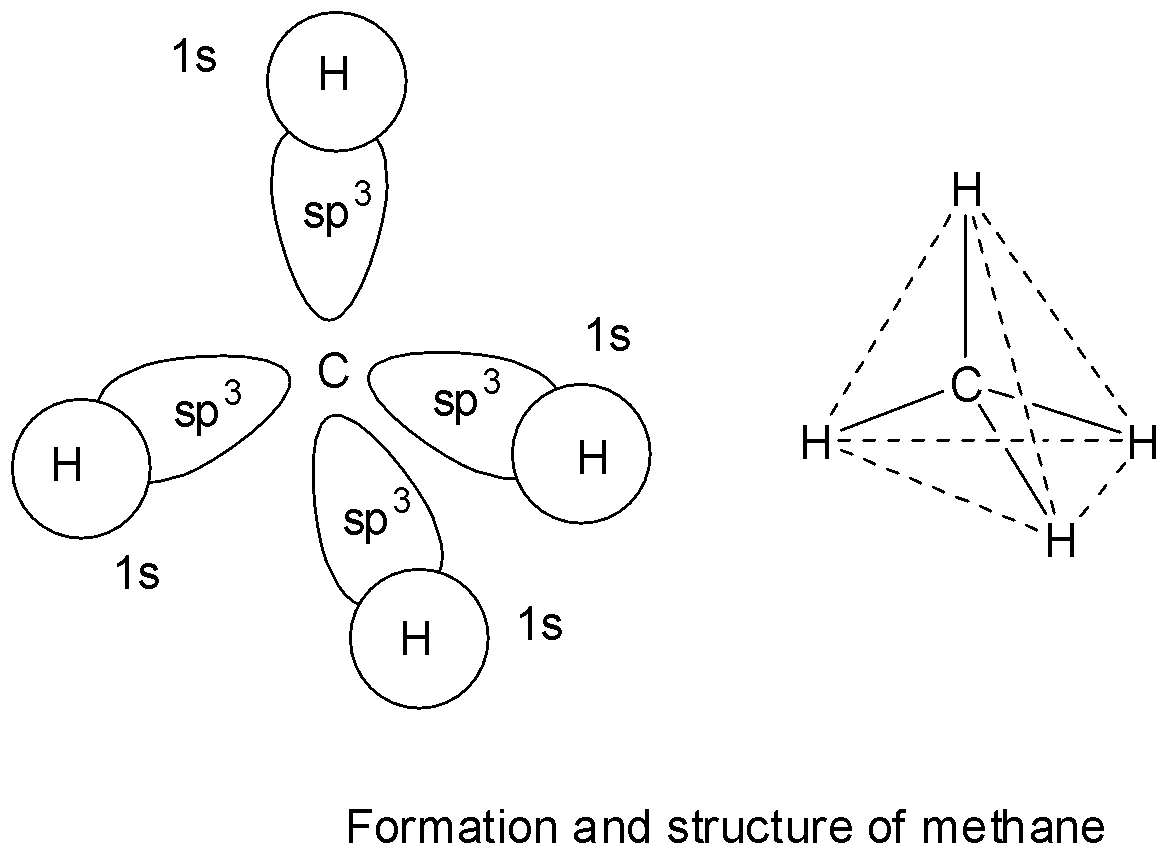
The hybridization on the central carbon in methane, ${\text{C}}{{\text{H}}_{\text{4}}}$ , is:
(A) ${\text{sp}}$
(B) ${\text{s}}{{\text{p}}^2}$
(C) ${\text{s}}{{\text{p}}^3}$
(D) ${\text{s}}{{\text{p}}^3}{\text{d}}$
Answer
133.5k+ views
Hint: The term hybridization is used to refer to the intermixing of atomic orbitals having nearly the same energies which result in their rearrangement to form completely different orbitals which are called hybrid orbitals. The hybridization and bond formation of carbon occurs in three ways: ${\text{s}}{{\text{p}}^3}$ , ${\text{s}}{{\text{p}}^2}$ and ${\text{sp}}$ hybridization.
Complete step by step answer:
In methane, carbon has 4 valence electrons and takes 4 more electrons to complete its octet. The four half filled orbitals of carbon in methane before getting involved in bond formation, mix up their energies and rearrange and redistribute equally to give four new and equivalent ${\text{s}}{{\text{p}}^3}$ hybrid orbitals which are directed at an angle of ${109^\circ }28'$ with respect to one another. These 4 ${\text{s}}{{\text{p}}^3}$ hybrid orbitals of carbon then overlap with 1s orbitals of 4 hydrogen atoms to give four ${\text{s - s}}{{\text{p}}^3}$ sigma bonds. The four bonds in methane are directed towards the 4 corners of a tetrahedron.
So, option C is correct.

* In ${\text{sp}}$ hybridization, the carbon atom in excited state is involved in the hybridization of its 2s orbital with one 2p orbital while the other two 2p orbitals are left unchanged. As a result, two new ${\text{sp}}$ hybrid orbitals form making an angle of ${180^\circ }$ with each other. The central carbon atom has linear shape. So, option A is wrong.
* In ${\text{s}}{{\text{p}}^2}$ hybridization, the carbon atom in excited state is involved in the hybridization of its 2s orbital with two 2p orbitals while the third 2p orbital is left unchanged. As a result, three new ${\text{s}}{{\text{p}}^2}$ hybrid orbitals are formed making an angle of ${120^\circ }$ with each other. So, option B is wrong.
Carbon cannot show ${\text{s}}{{\text{p}}^3}{\text{d}}$ hybridization as it is a p-block element and has no d-orbitals. So, option D is also wrong.
Note: The characteristics of hybridization are:
* The number of hybrid orbital that are formed are equal to that of the hybridizing orbitals.
* All the hybrid orbitals have equivalent energy and shape.
* Hybrid orbitals taking part in bond formation must have one electron in it.
* Electronic repulsions between the hybrid orbitals make them stay at the maximum distance apart.
Complete step by step answer:
In methane, carbon has 4 valence electrons and takes 4 more electrons to complete its octet. The four half filled orbitals of carbon in methane before getting involved in bond formation, mix up their energies and rearrange and redistribute equally to give four new and equivalent ${\text{s}}{{\text{p}}^3}$ hybrid orbitals which are directed at an angle of ${109^\circ }28'$ with respect to one another. These 4 ${\text{s}}{{\text{p}}^3}$ hybrid orbitals of carbon then overlap with 1s orbitals of 4 hydrogen atoms to give four ${\text{s - s}}{{\text{p}}^3}$ sigma bonds. The four bonds in methane are directed towards the 4 corners of a tetrahedron.
So, option C is correct.

* In ${\text{sp}}$ hybridization, the carbon atom in excited state is involved in the hybridization of its 2s orbital with one 2p orbital while the other two 2p orbitals are left unchanged. As a result, two new ${\text{sp}}$ hybrid orbitals form making an angle of ${180^\circ }$ with each other. The central carbon atom has linear shape. So, option A is wrong.
* In ${\text{s}}{{\text{p}}^2}$ hybridization, the carbon atom in excited state is involved in the hybridization of its 2s orbital with two 2p orbitals while the third 2p orbital is left unchanged. As a result, three new ${\text{s}}{{\text{p}}^2}$ hybrid orbitals are formed making an angle of ${120^\circ }$ with each other. So, option B is wrong.
Carbon cannot show ${\text{s}}{{\text{p}}^3}{\text{d}}$ hybridization as it is a p-block element and has no d-orbitals. So, option D is also wrong.
Note: The characteristics of hybridization are:
* The number of hybrid orbital that are formed are equal to that of the hybridizing orbitals.
* All the hybrid orbitals have equivalent energy and shape.
* Hybrid orbitals taking part in bond formation must have one electron in it.
* Electronic repulsions between the hybrid orbitals make them stay at the maximum distance apart.
Recently Updated Pages
JEE Main 2025 Session 2 Form Correction (Closed) – What Can Be Edited

Sign up for JEE Main 2025 Live Classes - Vedantu

JEE Main Books 2023-24: Best JEE Main Books for Physics, Chemistry and Maths

JEE Main 2023 April 13 Shift 1 Question Paper with Answer Key

JEE Main 2023 April 11 Shift 2 Question Paper with Answer Key

JEE Main 2023 April 10 Shift 2 Question Paper with Answer Key

Trending doubts
JEE Main 2025 Session 2: Application Form (Out), Exam Dates (Released), Eligibility, & More

JEE Main 2025: Conversion of Galvanometer Into Ammeter And Voltmeter in Physics

JEE Main 2025: Derivation of Equation of Trajectory in Physics

Electric Field Due to Uniformly Charged Ring for JEE Main 2025 - Formula and Derivation

Current Loop as Magnetic Dipole and Its Derivation for JEE

Inertial and Non-Inertial Frame of Reference - JEE Important Topic

Other Pages
NCERT Solutions for Class 11 Chemistry Chapter 9 Hydrocarbons

JEE Advanced Marks vs Ranks 2025: Understanding Category-wise Qualifying Marks and Previous Year Cut-offs

NCERT Solutions for Class 11 Chemistry Chapter 5 Thermodynamics

Hydrocarbons Class 11 Notes: CBSE Chemistry Chapter 9

NCERT Solutions for Class 11 Chemistry Chapter 7 Redox Reaction

Thermodynamics Class 11 Notes: CBSE Chapter 5




